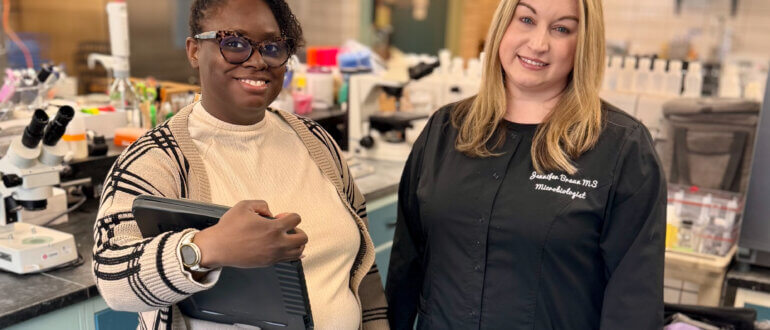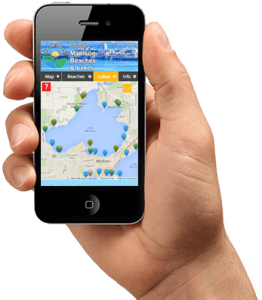An interview with Public Health Madison & Dane County
Parks and lakes define Greater Madison, offering plenty of public beaches to enjoy the water’s edge. In fact, we have 22 public beaches and official swimming locations on the Yahara chain of lakes (and more throughout Dane County). Every summer, Public Health Madison & Dane County (PHMDC) monitors the majority of these beaches from Memorial Day to Labor Day.
Clean Lakes Alliance’s Watershed Programs Manager Caitlin McAleavey sat down with PHMDC’s Jennifer Lavender Braun and Ronesha Strozier to learn how they test the beaches and what determines if they are open or closed.

Caitlin McAleavey (CM): Tell me about your role at Public Health Madison & Dane County.
Jennifer Lavender Braun (JLB): I’m the Lead Environmental Health Scientist at Public Health Madison & Dane County. Regarding beaches, I oversee our sampling schedule and analyze and report results.
Ronesha Strozier (RS): I am an Environmental Health Services Supervisor. I supervise the Environmental Laboratory Unit, which Jennifer leads, and the Environmental Protection Unit.
CM: How long have you been at Public Health?
JLB: Fourteen years.
RS: Three years.

PHMDC’s beach testing program
CM: How long has PHMDC been doing beach testing?
JLB: To my knowledge, beach testing has been going on for quite a while. Its role has expanded a lot over the years, but I have seen photos going back to the late 1950s and early 1960s of people on the lakes holding up a printed sign to document the testing date. So some sort of sampling has been going on for a long time. The sampling protocol we do today has been going on for decades.
CM: PHMDC tests 25 beaches and swimming locations in Dane County, 22 of them being along the Yahara chain of lakes. How do teams collect samples?
JLB: Each summer, we have two LTE staff members who drive around to collect water samples at each beach. Once back in the lab, they assist with the analysis. Sometimes, other full-time staffers or I go out to collect samples when needed.
CM: Only two? That’s a lot of ground to cover for only two people!
JLB: They split up, and each does 12 to 13 beaches in one day. It can take four to six hours, depending on conditions and what they run into when they’re at each beach. If there’s algae present, it might take them a little longer to take extra samples to bring back to the lab.

Observing local beaches
CM: You mentioned algae. What else are beach testers looking for?
JLB: Our staff is observing the overall conditions to see what might influence the results we get back in the lab. They look at how clean the beach is and if there’s a lot of waterfowl or waterfowl feces nearby [which can lead to an increase of E. coli]. Then they look at the water itself to see if there’s any visible algae present. If there is, does it look like harmful blue-green algae [cyanobacteria], or is it just green algae or duckweed?
CM: And I’m sure their testing equipment invites a lot of questions and conversation from beachgoers?
JLB: Yeah, we get a lot of questions. People often want to know what we’re doing and if it’s safe to swim, especially if they see we’re posting a beach closure sign. We get questions on whether they should be concerned about getting sick or their child getting sick. When that happens, we give general information on where to find beach closure updates, the signs and symptoms to look for, and refer them to their healthcare provider for further questions.
Safe to swim?
CM: How do you respond to the question, “Are our lakes safe to swim in?”
JLB: It depends on what someone means when they ask what safe is. A big reason why we do the testing is to try to protect the public from exposure so that they don’t get sick. Keeping a close eye on monitoring is important for people who want to enjoy the lakes. Even with harmful algal blooms, we may have a few beaches closed in one area, but we might have really nice conditions with a much lower risk at our other beaches. We want to provide that awareness and education to the public.

CM: Right, one beach closing doesn’t mean the entire lake closes. Where can the public find out about current beach closures?
RS: Online, search “beach testing at Public Health,” and it will pop up. We have an email listserv you can sign up for so you will be notified if something changes with that beach, either opening or closing. You can sign up for notifications on a specific beach or as many as you’d like. [LakeForecast.org also reports PHMDC beach closures.]
JLB: Also, when beaches are closed, our staff posts signage on either the lifeguard stand or nearby letting people know the beach is closed. We often tell people, “When in doubt, stay out just to be safe, especially with children and pets.” We’re not everywhere every minute of every day, and conditions can change quickly.
Beach testing schedule
CM: Is there a sampling schedule when beachgoers can expect to see your team out testing?
JLB: Yes, we usually do our routine sampling on Mondays and Tuesdays so that we can account for bad weather days or potential beach closures that require additional samples. If we get elevated results of E. coli or blue-green algae and a beach needs to be closed, our staff will go back out and resample it every day until levels come down and the beach can be reopened. So we can’t keep a completely strict schedule, but we try to start each week out with, okay, let’s get all our routine samples and go from there.
CM: How long does the lab take to return results after collecting a sample?
JLB: The E. coli test takes 18 hours, so we get those results back right away the following morning. When it comes to blue-green algae, we test for a certain toxin. That test takes 90 minutes, so we can get those results a lot sooner. Though, generally, if staff are confident that it’s a blue-green algae bloom, we will close the beach immediately. Even if a bloom isn’t producing toxin when we test it, it could start producing toxin at any time. We monitor for the presence of toxins so that when the bloom looks like it’s gone, we can confirm there’s no toxin still present in the water.

Rapid testing
CM: In 2024, PHMDC started a pilot program for rapid testing E. coli. What goes into rapid versus traditional lab testing?
JLB: The E. coli rapid tests can get us results in two to four hours versus the traditional 18-hour test — meaning we’d be able to close or reopen beaches quicker than we can now. However, there are a few limitations to the rapid test, like getting samples back to the lab quickly enough to make that test worth running. If we don’t get samples back in the lab until 2 p.m., is it beneficial to get results at 6 p.m. versus 7 a.m. the next morning?
We’ve tried to be more strategic with how we use rapid testing, like utilizing it on Fridays when we don’t often run E. coli tests because we wouldn’t get results until Saturday [when the lab isn’t staffed]. It could be used to reopen a beach so that it doesn’t have to stay unnecessarily closed the whole weekend. It could be used on a Monday morning to reopen a beach the same day, versus collecting the sample Monday and not getting the result until Tuesday. We are trying to see where it would be the most beneficial to integrate into our current monitoring program.
CM: I see, so the rapid testing equipment isn’t portable or able to be done on site.
JLB: And not only are these tests more expensive to run, but they also take a much more skilled scientist and analyst to run the rapid testing. You need someone trained in molecular testing. It’s a lot more sensitive of a test, where the traditional method we use can easily be taught to anyone with a general science background, like our summer LTEs.
Partnering with LakeForecast
CM: Each summer, Clean Lakes Alliance operates our citizen science water quality monitoring program, LakeForecast, notably at our public beaches. We encourage our trained monitors to report signs of cyanobacteria blooms to your staff. How has PHMDC applied LakeForecast data to advance its work?
JLB: LakeForecast brings awareness to the beaches and what we do and gives us additional information. We’ve gotten emails from monitors or people who live by a beach, and they are really great about sending photos. And a lot of times those photos will help me to immediately say, yes, that is a strong bloom and the beach needs to be closed. I can close it [online] right away and then send someone out there to get a sample to confirm it.
CM: Outside of LakeForecast monitors, do you encourage the public to send in photos of questionable beach conditions or if they see a cyanobacteria bloom forming?

RS: We’ve always encouraged people to reach out to us, especially via email. If residents notice something that isn’t quite right and have checked online to see if we’ve already closed the beach, sending pictures can be helpful. Pictures are worth a thousand words. They can send photos and location details to lab@publichealthmdc.com.
The future of beach testing
CM: What’s the future of beach testing at PHMDC?
RS: We’re generating a predictive model that will tell us which beaches are more susceptible to closures after large rain events. [With heavy rain events, more runoff goes into our lakes, increasing the chances of elevated E. coli levels at our beaches.] We just gave our beach data to our data team to track what patterns emerge regarding weather impacts on our beaches. Predictive modeling is used frequently in public health monitoring, and we’re excited to add this new model to our current testing protocols.
CM: Anything else you would like the public to know when it comes to beach testing?
RS: I’m thankful for a community that’s interested in our work and very supportive of beach testing. It makes it easier to pitch new ideas and push the program forward, like the new E. coli rapid testing capabilities or developing predictive modeling. And I’m so grateful for our staff and their commitment to public safety at our beaches!
This article first appeared in the 2025 Greater Madison Lake Guide. Read more from the publication.




